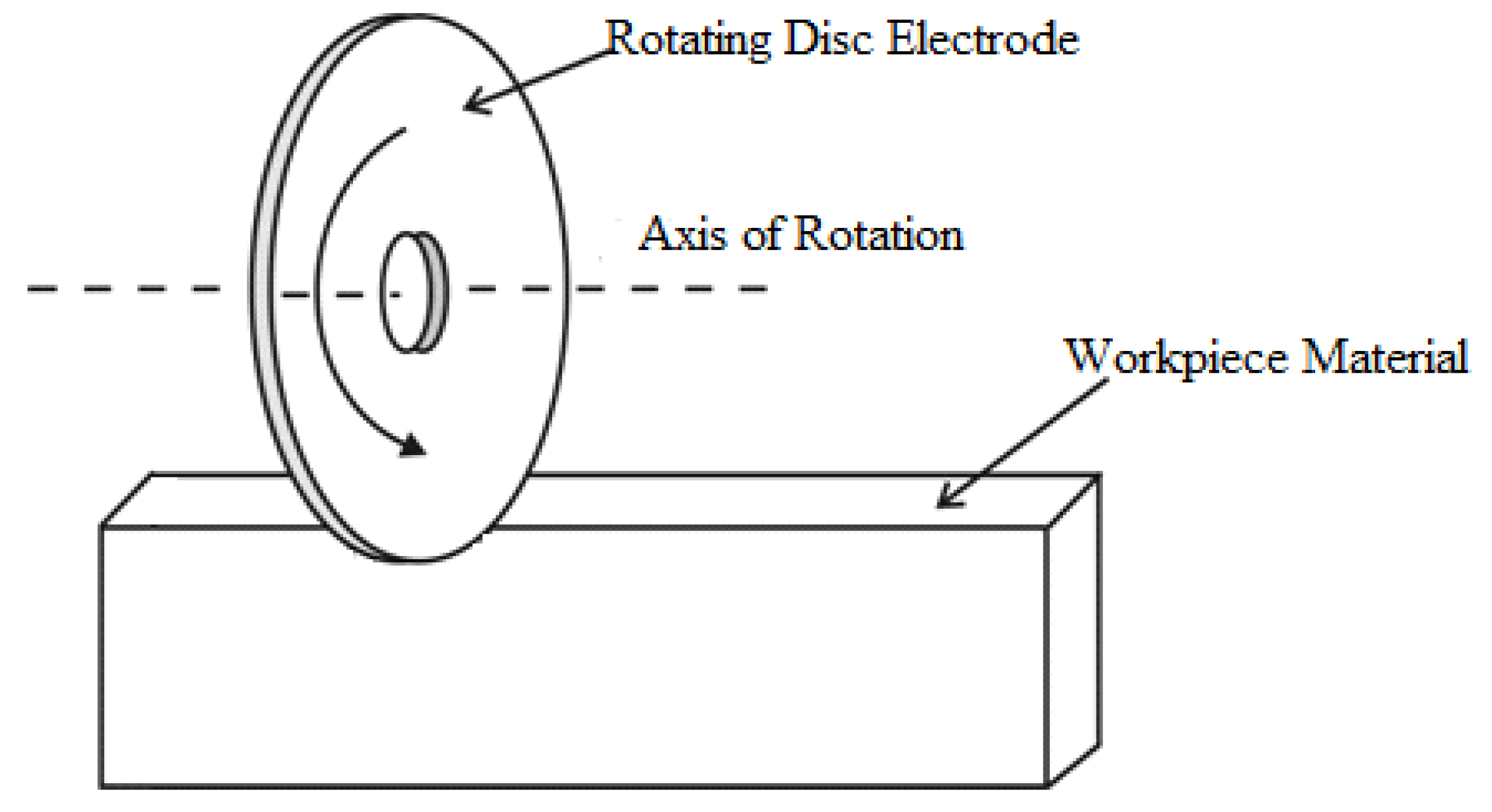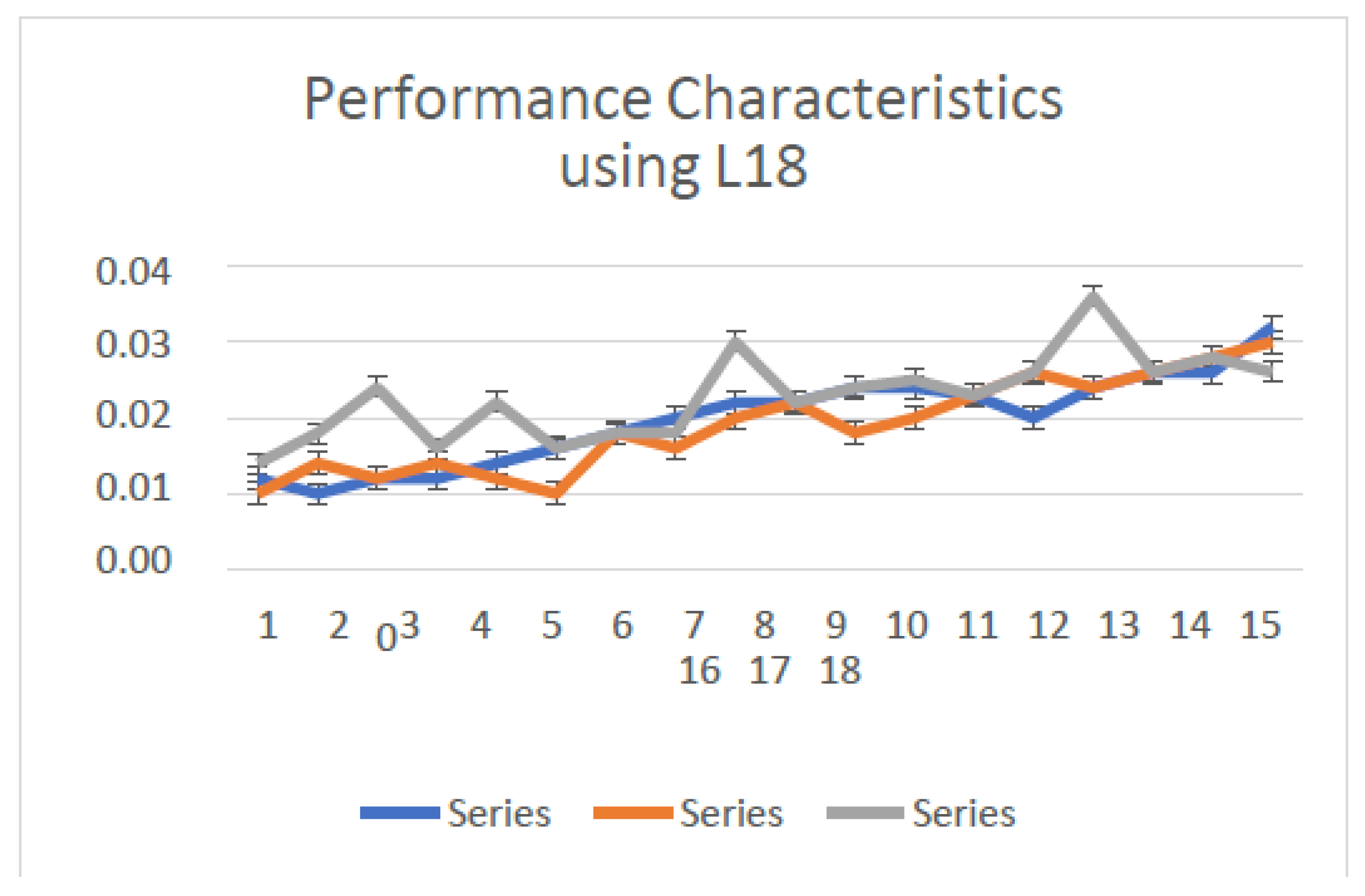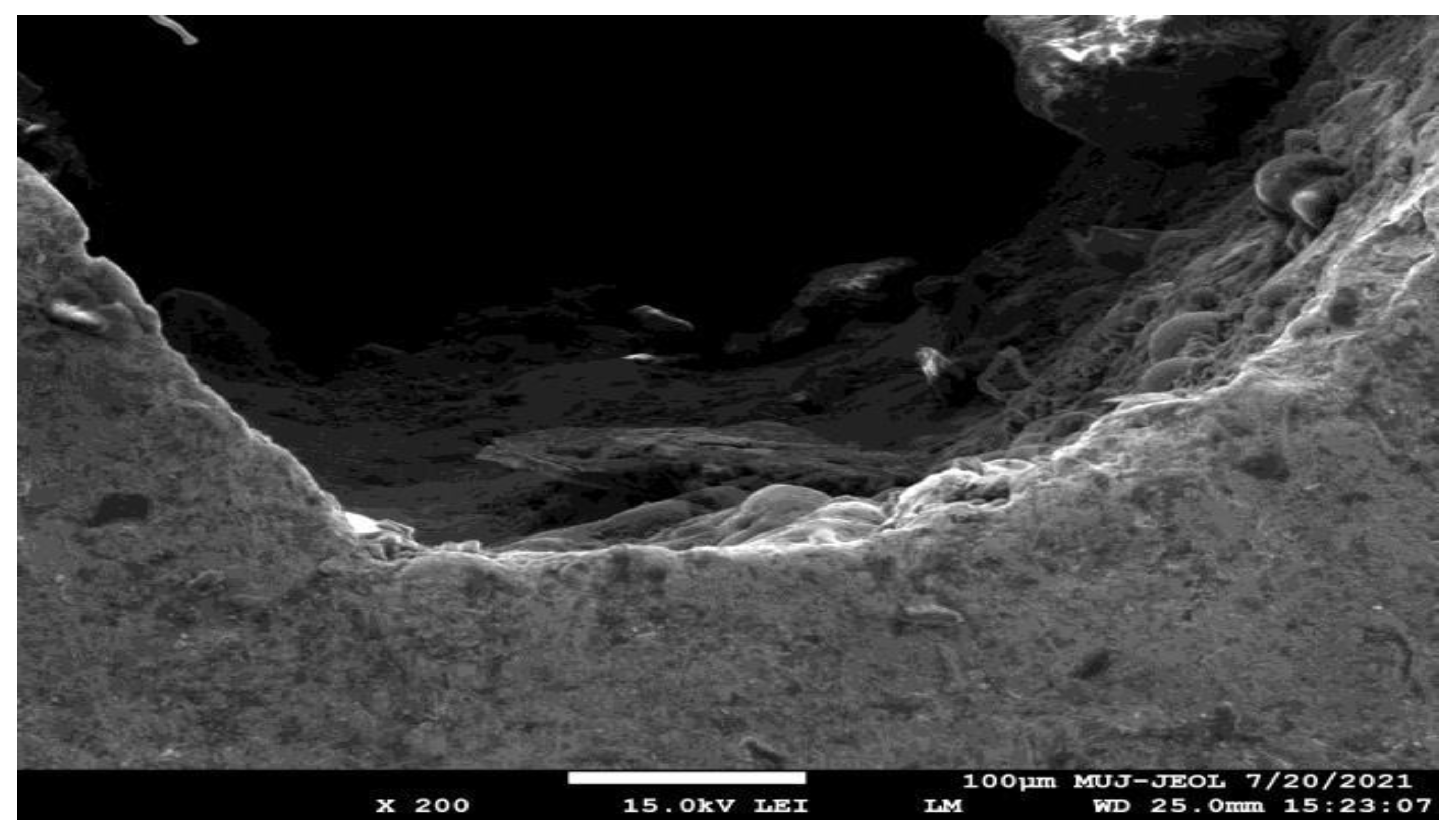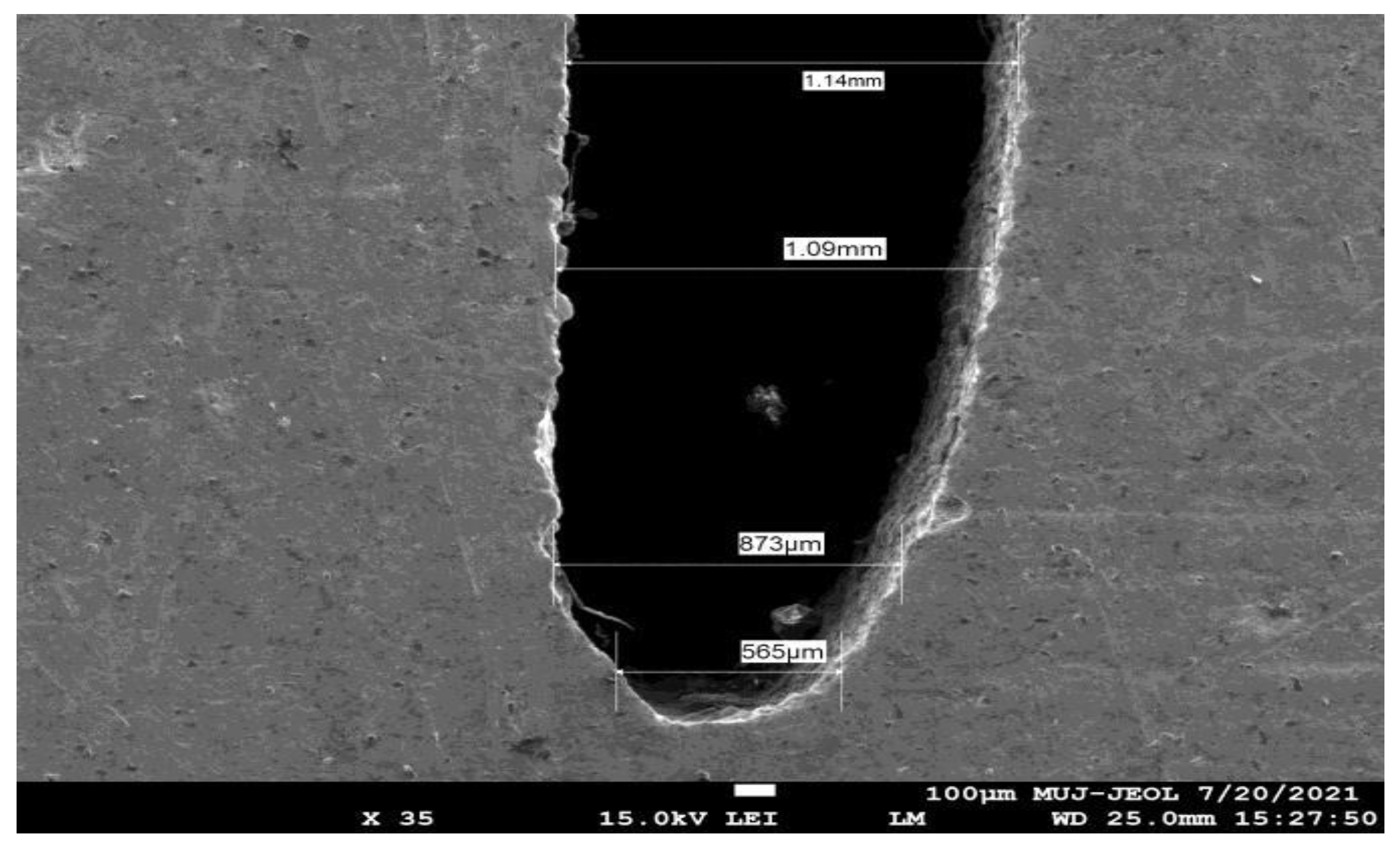Scanning Electron Microcopy Analysis after Electrical Discharge Machining of Advanced Ni-Based Alloy †
Abstract
:1. Introductory Theory
2. Materials Section
3. Taguchi’s Optimization Technique
4. Methods for Experimental Planning
5. Results and Analysis
6. Scanning Electron Microscopy (SEM) Analysis
7. Conclusions
Author Contributions
Funding
Institutional Review Board Statement
Informed Consent Statement
Data Availability Statement
Conflicts of Interest
References
- Goyal, A.; Pandey, A.; Rahman, H.U.R. Present and future prospective of shape memory alloys during machining by EDM/wire EDM process: A review. Sadhana—Acad. Proc. Eng. Sci. 2022, 47, 217. [Google Scholar] [CrossRef]
- Tian, Y.; Zhang, D.; Zhang, B. An experimental investigation on surface characteristics and material removal mechanism of Ti-6Al-4V in rotary ultrasonic-assisted electro-discharge machining. Int. J. Adv. Manuf. Technol. 2018, 94, 4153–4161. [Google Scholar]
- Kumar, R.; Pandey, A.; Sharma, P. Electrical discharge machining of Inconel 718 using cryo-processed rotary Cu-electrode. J. Sci. Ind. Res. 2020, 79, 691–695. [Google Scholar]
- Kumar, R.; Pandey, A.; Sharma, P. Investigation of Surface Roughness for Inconel 718 in Blind Hole Drilling with Rotary Tool Electrode. J. Adv. Manuf. Syst. 2019, 18, 379–394. [Google Scholar] [CrossRef]
- Kumar, R.; Pandey, A.; Sharma, P. Analysis of dimensional accuracy (Over cut) and surface quality (roughness) in electrical discharge machining of inconel-718 alloy. Mater. Sci. Forum 2019, 969, 644–649. [Google Scholar]
- Pandey, A.; Kumar, R. Some studies using Cryogenically treated Rotary Cu-tool electrode Electrical Discharge Machining. Proc. Mater. Today 2018, 5, 7635–7639. [Google Scholar] [CrossRef]
- Goyal, A.; Pandey, A.; Sharma, P. An experimental study of aerospace material during fabrication of V groove using WEDM. Int. J. Mech. Prod. Eng. Res. Dev. 2017, 7, 249–258. [Google Scholar]
- Singh, S.; Pandey, A. Some studies into electrical discharge machining of Nimonic75 super alloy using rotary copper disk electrode. J. Mater. Eng. Perform. 2013, 22, 1290–1303. [Google Scholar] [CrossRef]
- Jhamb, S.; Goyal, S.K.; Pandey, A.; Verma, M.N. Mechanical, Wear, and Degradation Behavior of Biodegradable Mg-x% Sn Alloy Fabricated through Powder Mixing Techniques. J. Mater. Eng. Perform. 2022, 32, 7123–7133. [Google Scholar] [CrossRef]
- Goyal, A.; Pandey, A.; Sharma, P.; Kumar, R.; Namdev, S. Performance study of surface integrity of Inconel 625 by DoE approach during WEDM machining. In Optimization Methods in Engineering: Select Proceedings of CPIE; Springer: Singapore, 2019; pp. 337–348. [Google Scholar]
- Goyal, A.; Pandey, A.; Sharma, P. Machinability of Inconel 625 aerospace material using cryogenically treated WEDM. Solid State Phenom. 2017, 266, 38–42. [Google Scholar]
- Jhamb, S.; Matai, M.; Goyal, A.; Pandey, A. A comprehensive analysis on magnesium-based alloys and metal matrix composites for their in-vitro biocompatibility. Adv. Mater. Process. Technol. 2022, 3, 1249–1282. [Google Scholar] [CrossRef]
- Goyal, A.; Pandey, A.; Sharma, P.; Sharma, S.K. Study on Ni-based super alloy using cryogenic treated electrode by Taguchi methodology. Mater. Today Proc. 2017, 4, 2068–2076. [Google Scholar] [CrossRef]
- Khan, A.; Gokul, A.K.; Bharani Dharan, M.P.; Jeeva Karthikeyan, R.V.S.; Uthaya Kumar, M.S.; Thirumalai Kumaran, S.; Duraiselvam, M. Machinability of nickel-based alloys using electrical discharge machining process. IOP Conf. Ser. Mater. Sci. Eng. 2018, 346, 012044. [Google Scholar] [CrossRef]
- Rohmat, Y.; Pradana, A.; Ferara, A.; Aminnudin, A.; Wahono, W.; Ching Jang, J.S. The Effect of Discharge Current and Pulse-On Time on Biocompatible Zr-based BMG Sinking-EDM. Open Eng. 2020, 10, 401–407. [Google Scholar]
- Mouralova, K.; Zahradnicek, R.; Benes, L.; Prokes, T.; Hrdy, R.; Fries, J. Study of Micro Structural Material Changes after WEDM Based on TEM Lamella Analysis. Metals 2020, 10, 949. [Google Scholar] [CrossRef]
- Saini, A.; Singh, D. The effect of coating morphology on anti-corrosion behavior of modified alumina coating over aluminum alloy. Prot. Met. Phys. Chem. Surf. 2021, 57, 995–1001. [Google Scholar] [CrossRef]
- Saini, A.; Singh, D.; Agarwal, D.C.; Dhayal, V. Structural Characterization and Protective Properties of Spray-Deposited Titania Coating Obtained from Oxime-Modified Titanium (IV) Precursor. Prot. Met. Phys. Chem. Surf. 2022, 58, 615–622. [Google Scholar] [CrossRef]
- Yavari, S.; Modabberifar, M.; Sheykholeslami, M.R. An experimental investigation of electro discharge machining parameters effects on ferromagnetic properties of extra-low-carbon steel. J. Magn. Magn. Mater. 2022, 549, 169041. [Google Scholar] [CrossRef]
- Chakmakchi, M.; Ntasi, A.; Mueller, W.D. Effect of Cu and Ti electrodes on surface and electrochemical properties of Electro Discharge Machined (EDMed) structures made of Co-Cr and Ti dental alloys. Dent. Mater. 2021, 37, 588–596. [Google Scholar] [CrossRef] [PubMed]
- Mohapatra, S.; Sahoo, A.K. Comparative study of Inconel 601, 625, 718, 825 super-alloys during Electro-Discharge Machining. Mater. Today Proc. 2022, 56, 226–230. [Google Scholar] [CrossRef]





| Machine Tool | CNC EDM |
|---|---|
| Work tank size | 600 × 400 × 275 mm |
| Worktable dimensions | 500 × 300 mm |
| Longitudinal and cross travel | 500 × 200 × 250 mm |
| Feed motor (Z-axis) | DC Servo |
| Dielectric fluid system | Integral with machine tool |
| Pulse generator type | 4 KVA, 440 V, 3 phase, 50 A |
| Parameters | Symbol | Unit | Level 1 | Level 2 | Level 3 |
|---|---|---|---|---|---|
| Electrode thickness | t | mm | 0.1 | 0.3 | - |
| Peak current | Ip | A | 6 | 10 | 12 |
| Pulse-ON time | Ton | µs | 110 | 150 | 250 |
| Pulse-OFF time | Toff | µs | 40 | 60 | 100 |
| Gap Voltage | Vg | V | 40 | 45 | 120 |
| Rotational Speed | N | rpm | 40 | 80 | 120 |
| Process Parameters | ||||||
|---|---|---|---|---|---|---|
| S. No. | Electrode Thickness (t) | Current (A) | Ton (µs) | Toff (µs) | Vg (V) | Speed (N) |
| 1. | 1 | 1 | 1 | 1 | 1 | 1 |
| 2. | 1 | 1 | 2 | 2 | 2 | 2 |
| 3. | 1 | 1 | 3 | 3 | 3 | 3 |
| 4. | 1 | 2 | 1 | 1 | 2 | 2 |
| 5. | 1 | 2 | 2 | 2 | 3 | 3 |
| 6. | 1 | 2 | 3 | 3 | 1 | 1 |
| 7. | 1 | 3 | 1 | 2 | 1 | 3 |
| 8. | 1 | 3 | 2 | 3 | 2 | 1 |
| 9. | 1 | 3 | 3 | 1 | 3 | 2 |
| 10. | 2 | 1 | 1 | 3 | 3 | 2 |
| 11. | 2 | 1 | 2 | 1 | 1 | 3 |
| 12. | 2 | 1 | 3 | 2 | 2 | 1 |
| 13. | 2 | 2 | 1 | 2 | 3 | 1 |
| 14. | 2 | 2 | 2 | 3 | 1 | 2 |
| 15. | 2 | 2 | 3 | 1 | 2 | 3 |
| 16. | 2 | 3 | 1 | 3 | 2 | 3 |
| 17. | 2 | 3 | 2 | 1 | 3 | 1 |
| 18. | 2 | 3 | 3 | 2 | 1 | 2 |
Disclaimer/Publisher’s Note: The statements, opinions and data contained in all publications are solely those of the individual author(s) and contributor(s) and not of MDPI and/or the editor(s). MDPI and/or the editor(s) disclaim responsibility for any injury to people or property resulting from any ideas, methods, instructions or products referred to in the content. |
© 2023 by the authors. Licensee MDPI, Basel, Switzerland. This article is an open access article distributed under the terms and conditions of the Creative Commons Attribution (CC BY) license (https://creativecommons.org/licenses/by/4.0/).
Share and Cite
Pandey, A.; Goyal, A.; Walia, R.; Jurwall, V. Scanning Electron Microcopy Analysis after Electrical Discharge Machining of Advanced Ni-Based Alloy. Eng. Proc. 2023, 59, 52. https://doi.org/10.3390/engproc2023059052
Pandey A, Goyal A, Walia R, Jurwall V. Scanning Electron Microcopy Analysis after Electrical Discharge Machining of Advanced Ni-Based Alloy. Engineering Proceedings. 2023; 59(1):52. https://doi.org/10.3390/engproc2023059052
Chicago/Turabian StylePandey, Anand, Ashish Goyal, Ranjan Walia, and Varun Jurwall. 2023. "Scanning Electron Microcopy Analysis after Electrical Discharge Machining of Advanced Ni-Based Alloy" Engineering Proceedings 59, no. 1: 52. https://doi.org/10.3390/engproc2023059052
APA StylePandey, A., Goyal, A., Walia, R., & Jurwall, V. (2023). Scanning Electron Microcopy Analysis after Electrical Discharge Machining of Advanced Ni-Based Alloy. Engineering Proceedings, 59(1), 52. https://doi.org/10.3390/engproc2023059052






